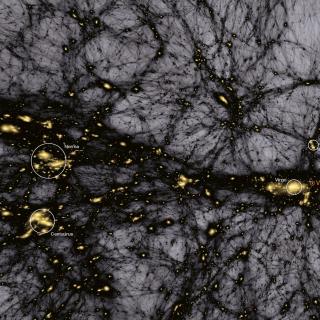Bibcode
Balaguera-Antolínez, A.; Bilicki, M.; Branchini, E.; Postiglione, A.
Referencia bibliográfica
Monthly Notices of the Royal Astronomical Society, Volume 476, Issue 1, p.1050-1070
Fecha de publicación:
5
2018
Número de citas
32
Número de citas referidas
31
Descripción
Using the almost all-sky 2MASS Photometric Redshift catalogue (2MPZ) we
perform for the first time a tomographic analysis of galaxy angular
clustering in the local Universe (z < 0.24). We estimate the angular
auto- and cross-power spectra of 2MPZ galaxies in three photometric
redshift bins, and use dedicated mock catalogues to assess their errors.
We measure a subset of cosmological parameters, having fixed the others
at their Planck values, namely the baryon fraction
fb=0.14^{+0.09}_{-0.06}, the total matter density parameter
Ωm = 0.30 ± 0.06, and the effective linear bias
of 2MPZ galaxies beff, which grows from 1.1^{+0.3}_{-0.4} at
= 0.05 up to 2.1^{+0.3}_{-0.5} at = 0.2, largely
because of the flux-limited nature of the data set. The results obtained
here for the local Universe agree with those derived with the same
methodology at higher redshifts, and confirm the importance of the
tomographic technique for next-generation photometric surveys such as
Euclid or Large Synoptic Survey Telescope.
Proyectos relacionados

Cosmología con Trazadores de la Estructura a Gran Escala del Universo
El Fondo Cósmico de Microondas (FCM) contiene la información estadística de las semillas primigenias que han dado lugar a la formación de todas las estructuras en el Universo. Su contrapartida natural en el Universo local es la distribución de las galaxias que surgen como resultado del crecimiento gravitatorio de aquellas fluctuaciones de densidad
FRANCISCO SHU
KITAURA JOYANES